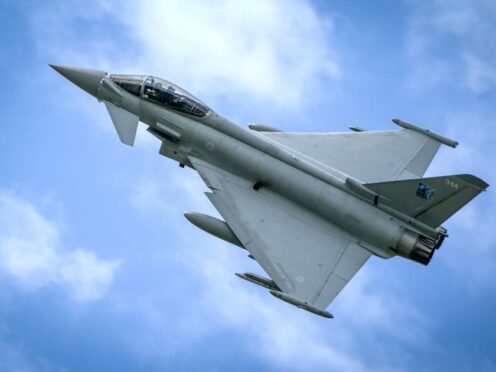
British RAF fighter jets shot down a number of Iranian drones fired at targets in Israel, Rishi Sunak confirmed on Sunday.
Israel said Iran launched 170 drones, more than 30 cruise missiles and more than 120 ballistic missiles in its Saturday night attack.
The Prime Minister told journalists in Downing Street: “I can confirm that our planes did shoot down a number of Iranian attack drones. I want to pay tribute to the bravery and professionalism of our pilots flying into the face of danger to protect civilians.”
Here the PA news agency takes a closer look at the fighter jets used to defend Israel.
– Which fighter jets were used to shoot down Iranian drones?
The warplanes used to shoot down an unconfirmed number of Iranian drones were Typhoon FGR4s, twin-engine fighter jets with a 36ft (11m) wingspan armed with air-to-air missiles, precision-guided bombs and air-to-ground projectiles.
Typhoons can reach maximum speeds of 1,381mph – almost twice the speed of sound – and a single jet costs some £120m.

They have a maximum altitude of 55,000ft (17,000m).
The RAF’s Typhoon force consisted of 137 aircraft in seven squadrons as of February 2023.
The fighter jets are supported by Voyager aircraft, 192ft (59m) long air-to-air refuelling tankers equipped with two underwing pods for restocking the Typhoons over long ranges.
The tankers are just slower than the speed of sound, have a 198ft (60m) wingspan and can carry 111,000kg of fuel.
– What are the strengths and weaknesses of the Typhoon fighter jet?
The RAF describes the Typhoon FGR4 as an “extremely agile, multi-role combat aircraft” which underpins its military operations at home and abroad.
Typhoons are incredibly manoeuvrable aircraft, boasting high turn rates, impressive top speeds and rapid vertical acceleration.
They are equipped with a technologically advanced weapons system, including Enhanced Paveway II and Paveway IV laser-guided precision bombs.
The jets are also furnished with Meteor, an advanced radar-guided, beyond-visual-range air-to-air missile (BVRAAM) which can engage autonomously at day or night regardless of weather conditions at ranges exceeding 60 miles (100km).

The aircraft’s pilot wears a sophisticated helmet known as the Helmet Mounted Symbology System (HMSS), which allows them to “see” through the body of the aircraft, giving them a vital advantage in split-second decision-making, according to BAE Systems.
The British company described the helmet – which allows a pilot to lock on to multiple targets simply by moving their head and prioritise them by voice commands – as “like something out of Star Wars”.
The warplanes’ weaknesses include their staggering production costs – which drew criticism from MPs in 2011 – and their limited stealth capacities.
– What presence does the UK’s air force have in the Middle East?
The RAF’s operational headquarters in the Middle East is at Al Udeid air base in Qatar, which it shares with the United States Air Force (USAF) and Qatar Emiri Air Force (QEAF). The base is responsible for co-ordinating the RAF’s contribution to Operation Shader, a military intervention against the so-called Islamic State in Syria and Iraq.
However, it is understood the RAF Typhoons used to intercept the Iranian drone attack were deployed from Cyprus, where the force operates a Permanent Joint Operating Base.
Jets from RAF Akrotiri were deployed from the island nation to help protect Israel – though its president Nikos Christodoulides said he had not been forewarned of the decision to mobilise aircraft from the base.
These aircraft shot down the attack drones in Syrian and Iraqi airspace.
The Government has since confirmed that it will be deploying more jets and air refuelling tankers to bolster its presence in the Middle East.

Enjoy the convenience of having The Sunday Post delivered as a digital ePaper straight to your smartphone, tablet or computer.
Subscribe for only £5.49 a month and enjoy all the benefits of the printed paper as a digital replica.
Subscribe